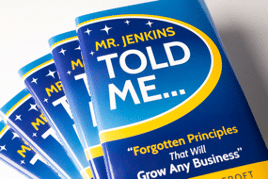What’s the point of branding?
Isn’t it not only to attract but to keep the right customers? If so, then which brand does that job better than any other? What brand is best at attracting customers and keeping them coming back?
Ask a stadium full of marketing experts, and most will answer Apple. That would be consistent with Brand Key’s latest annual loyalty study. According to the study, the 2022 Customer Loyalty leaders were:
- Apple (smartphones)
- Amazon (online retail)
- Domino’s (pizza)
- Disney+ (streaming video)
- TikTok (social networking)
Apple is very good at both attracting and keeping customers. There’s no doubt about that. However, Apple has been around for less than 50 years. The oldest company on that list – Domino’s, has been around a little more than 60 years.
That’s nothing.
 Since 1990, I’ve studied the one brand that both attracts and keeps customers coming back longer than any other.
Since 1990, I’ve studied the one brand that both attracts and keeps customers coming back longer than any other.
Not just for 50 years, but for 50 centuries. The companies on this list couldn’t begin to dream of that level of fanatical loyalty.
This brand has tested, refined and proven their techniques around the world in the most competitive markets known to man. The techniques they used 1000 years ago still work today. The exact same techniques have been adopted with great success by:
- Entertainers & Celebrities
- Pro Sports Franchises
- Military Organizations
- Political Organizations
Oh, and also by Apple.
The techniques work for any type of organization that serves humans. The techniques work because they tickle the human brain in just the right way. If you learn to apply these tools, they will work for your business as well.
Now, before I explain, allow me to set the context with a brief story.
Mr. Jenkins Told Me…
 I’m reading a book right now called Mr. Jenkins Told Me… and I’m getting all choked up. Why? It’s just a collection of short stories about the founder of an air conditioning company. Why would something so lightweight – so frivolous – make me weepy? For that matter, why would such stories make anyone weepy?
I’m reading a book right now called Mr. Jenkins Told Me… and I’m getting all choked up. Why? It’s just a collection of short stories about the founder of an air conditioning company. Why would something so lightweight – so frivolous – make me weepy? For that matter, why would such stories make anyone weepy?
I used to get angry with myself when I’d get emotional about “silly” things like the stories in this book. I thought I was defective.
But time and experience taught me otherwise. I learned that what I once perceived as a defect is in fact evidence of a profound, powerful, and irresistible process at work in my sub-conscious.
Let me illustrate how it works with another story.
The Brain Science of Old Printers
Back when it was legal to smoke in bars, I worked for a small mail order computer company called PC’s Limited. We advertised in computer magazines like PC and Byte. People would call our 800 number to order the latest and greatest computer accessory.[i]
When someone called to order a printer, we had to ask them a particularly important question:
 “Does your computer have a serial interface, or a parallel interface?”
“Does your computer have a serial interface, or a parallel interface?”
See, a computer with a serial interface couldn’t talk to a parallel printer, and vice versa.
“What’s the difference?” you ask.
Serial printers process data one bit at a time. A parallel interface sends data to the printer 8 times faster than a serial interface – one byte at a time. A serial printer is completely overwhelmed by the speed of a parallel interface.
(I’m gonna generalize now. All you brain scientists, please take a deep breath and chill out.)
We humans actually have two brains: left and right. The left brain is the rational brain. It processes information in a serial fashion. Call it “1 bit at a time.” The right brain is the intuitive brain. It processes information in parallel. Call it “1 byte at a time.”

Just like old printer interfaces, our parallel brain is a whole lot faster than our serial brain. In other words, our Intuition works a whole lot faster than our Reason.[ii]
This is how we can know things intuitively long before we understand them rationally.
Here’s the big idea:
Parallel messages overwhelm the processing abilities of the serial brain. Whenever that happens, the body responds with emotion: sometimes confusion or anger, sometimes tears of joy. Recognize this signal when it happens to you. It means you’ve just learned something meaningful to you. Your Intuition already groks it; your Reason just hasn’t caught up yet.
This is why Reason mistrusts Intuition: Reason rides the short bus. It lacks the bandwidth to arrive at conclusions as fast as Intuition gets there. As a consequence, Reason just assumes Intuition is either lying or cheating.
The Envelope, Please…
So, what’s the brand?
Religion.
Now, take a deep breath as I unpack this for you. I promise not to gore any sacred cows nor offend any deities. (None of the major ones, anyway.)
The secret to Religion’s marketing genius is that they use techniques that operate faster than logic.
Religion knows how to leverage those sub-conscious, right-brain processes to not only attract but to keep customers for life.
Religion wastes no effort trying to communicate with the serial-rational left brain. Instead, Religion focuses its message on the parallel-intuitive right brain.
So, what does all this have to do with marketing your business?
The Wrong Ways to Talk to the Right Brain
Now, there are 2 wrong ways and 1 right way to speak to the parallel-intuitive right brain.
The wrong ways are Rational Argument and Transparent Emotional Manipulation.
Rational Argument appeals to our slow, rational, left brain. You see examples of it all the time:
- “Buy one, get one free!”
- “Offer good till the end of the month.”
- “Use this coupon for 10% off.”
- “Satisfaction guaranteed or your money back.”
Such offers make Rational sense. They can generate momentary action. But they lack power to capture the heart.
Now, some midwits recognized these limitations of Rational Argument and decided the solution was Transparent Emotional Manipulation. That’s how we end up with Hallmark Movie Commercials™. They tug at the heartstrings, but don’t deliver the goods.
Transparent Emotional Manipulation is worse than bloodless Rational Argument.
That’s not how great religions work. That’s not how great marketing works either.
The world’s great religions grant little attention to Rational Argument and even less to Transparent Emotional Manipulation.
Instead, they speak to the right brain using language the right brain understands.
So, that begs the question: What is the right way to talk to the right brain?
The Language of the Right Brain: Meaning
One big clue comes from your body. When you observe emotions welling up inside you, but you don’t know why, that’s your clue. Your body is sending you a signal in the guise of an unexplained emotion.
Something has touched the deep part of your soul, in that place where your deepest identity lives. That Something makes your heart ring like a crystal bell.
At this point, your serial-rational left brain not only doesn’t understand what is happening, it probably isn’t even aware of it.
What is it?
Meaning.
You know it in your gut, even when you can’t articulate it.
This is how religion creates fanatical loyalty. The generational “customers” of Religion have found something that gives them Meaning. As a result, the brand is impervious to Logic, immune to Reason, and unmoved by Argument.
Now pause for a moment. Join me in a thought experiment: What if your brand gave your customers the gift of Meaning?
You can do this.
In an earlier article, I explained how to get started by using just one facet of one technique: Personality. Next time, I’ll expand on the theme.
If you’re ready to make every point of contact with your customer into a “personality encounter” that will transform your slightly-better-than-average brand into a lovable, personable powerhouse brand, we should talk.
[i] More than 30 years later, I still remember the phone number: 800-426-5150. It’s a code. Drop me note if you know what it means.
[ii] Daniel Kahnemann won a Noble Prize in neuroscience for his work in what he calls the “fast brain and the slow brain.” You can read more about it in his book Thinking Fast, Thinking Slow.
- What is the Most Direct Cause of Customer Loyalty? - January 5, 2024
- How to Increase Brand Loyalty - September 1, 2023
- The Itch Which Must Be Scratched - June 13, 2023
